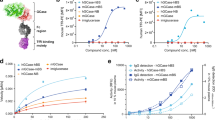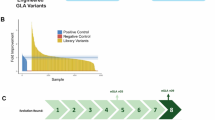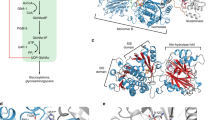Abstract
Gaucher disease results from mutations in the lysosomal enzyme acid β-glucosidase (GCase)1. Although enzyme replacement therapy has improved the health of some affected individuals, such as those with the prevalent N370S mutation, oral treatment with pharmacological chaperones may be therapeutic in a wider range of tissue compartments by restoring sufficient activity of endogenous mutant GCase2. Here we demonstrate that isofagomine (IFG, 1) binds to the GCase active site, and both increases GCase activity in cell lysates and restores lysosomal trafficking in cells containing N370S mutant GCase. We also compare the crystal structures of IFG-bound GCase at low pH with those of glycerol-bound GCase at low pH and apo-GCase at neutral pH. Our data indicate that IFG induces active GCase, which is secured by interactions with Asn370. The design of small molecules that stabilize substrate-bound conformations of mutant proteins may be a general therapeutic strategy for diseases caused by protein misfolding and mistrafficking.
This is a preview of subscription content, access via your institution
Access options
Subscribe to this journal
Receive 12 print issues and online access
$259.00 per year
only $21.58 per issue
Buy this article
- Purchase on Springer Link
- Instant access to full article PDF
Prices may be subject to local taxes which are calculated during checkout





Similar content being viewed by others
References
Sawkar, A.R., D'Haeze, W. & Kelly, J.W. Therapeutic strategies to ameliorate lysosomal storage disorders–a focus on Gaucher disease. Cell. Mol. Life Sci. 63, 1179–1192 (2006).
Fan, J.Q. A contradictory treatment for lysosomal storage disorders: inhibitors enhance mutant enzyme activity. Trends Pharmacol. Sci. 24, 355–360 (2003).
Grace, M.E., Newman, K.M., Scheinker, V., Berg-Fussman, A. & Grabowski, G.A. Analysis of human acid beta-glucosidase by site-directed mutagenesis and heterologous expression. J. Biol. Chem. 269, 2283–2291 (1994).
Butters, T.D., Dwek, R.A. & Platt, F.M. Imino sugar inhibitors for treating the lysosomal glycosphingolipidoses. Glycobiology 15, 43R–52R (2005).
Beutler, E. & Gelbart, T. Glucocerebrosidase (Gaucher disease). Hum. Mutat. 8, 207–213 (1996).
Wong, K. et al. Neuropathology provides clues to the pathophysiology of Gaucher disease. Mol. Genet. Metab. 82, 192–207 (2004).
Goker-Alpan, O. et al. Glucocerebrosidase mutations are an important risk factor for Lewy body disorders. Neurology 67, 908–910 (2006).
Liou, B. et al. Analyses of variant acid beta -glucosidases: effects of gaucher disease mutations. J. Biol. Chem. 281, 4242–4253 (2006).
Elstein, D. et al. Sustained therapeutic effects of oral miglustat (Zavesca, N-butyldeoxynojirimycin, OGT 918) in type I Gaucher disease. J. Inherit. Metab. Dis. 27, 757–766 (2004).
Pastores, G.M., Barnett, N.L. & Kolodny, E.H. An open-label, noncomparative study of miglustat in type I Gaucher disease: efficacy and tolerability over 24 months of treatment. Clin. Ther. 27, 1215–1227 (2005).
Ulloa-Aguirre, A., Janovick, J.A., Brothers, S.P. & Conn, P.M. Pharmacologic rescue of conformationally-defective proteins: implications for the treatment of human disease. Traffic 5, 821–837 (2004).
Alfonso, P. et al. Miglustat (NB-DNJ) works as a chaperone for mutated acid beta-glucosidase in cells transfected with several Gaucher disease mutations. Blood Cells Mol. Dis. 35, 268–276 (2005).
Lin, H. et al. N-octyl-beta-valienamine up-regulates activity of F213I mutant beta-glucosidase in cultured cells: a potential chemical chaperone therapy for Gaucher disease. Biochim. Biophys. Acta 1689, 219–228 (2004).
Mellor, H.R., Platt, F.M., Dwek, R.A. & Butters, T.D. Membrane disruption and cytotoxicity of hydrophobic N-alkylated imino sugars is independent of the inhibition of protein and lipid glycosylation. Biochem. J. 374, 307–314 (2003).
Kolter, T. & Wendeler, M. Chemical chaperones–a new concept in drug research. ChemBioChem 4, 260–264 (2003).
Steet, R.A. et al. The iminosugar isofagomine increases the activity of N370S mutant acid beta-glucosidase in Gaucher fibroblasts by several mechanisms. Proc. Natl. Acad. Sci. USA 103, 13813–13818 (2006).
Dvir, H. et al. X-ray structure of human acid-beta-glucosidase, the defective enzyme in Gaucher disease. EMBO Rep. 4, 704–709 (2003).
Premkumar, L. et al. X-ray structure of human acid-beta-glucosidase covalently bound to conduritol-B-epoxide. Implications for Gaucher disease. J. Biol. Chem. 280, 23815–23819 (2005).
Miao, S. et al. Identification of Glu340 as the active-site nucleophile in human glucocerebrosidase by use of electrospray tandem mass spectrometry. J. Biol. Chem. 269, 10975–10978 (1994).
Salvioli, R. et al. The N370S (Asn370 → Ser) mutation affects the capacity of glucosylceramidase to interact with anionic phospholipid-containing membranes and saposin C. Biochem. J. 390, 95–103 (2005).
Osiecki-Newman, K., Fabbro, D., Legler, G., Desnick, R.J. & Grabowski, G.A. Human acid beta-glucosidase: use of inhibitors, alternative substrates and amphiphiles to investigate the properties of the normal and Gaucher disease active sites. Biochim. Biophys. Acta 915, 87–100 (1987).
Berent, S.L. & Radin, N.S. Mechanism of activation of glucocerebrosidase by co-beta-glucosidase (glucosidase activator protein). Biochim. Biophys. Acta 664, 572–582 (1981).
Qi, X. & Grabowski, G.A. Acid beta-glucosidase: intrinsic fluorescence and conformational changes induced by phospholipids and saposin C. Biochemistry 37, 11544–11554 (1998).
Otwinowski, Z. & Minor, W. Processing of X-ray diffraction data collected in oscillation mode. Methods Enzymol. 276, 307–326 (1997).
Collaborative Computational Project, Number 4. The CCP4 suite: programs for protein crystallography. Acta Crystallogr. D Biol. Crystallogr. 50, 760–763 (1994).
Emsley, P. & Cowtan, K. Coot: model-building tools for molecular graphics. Acta Crystallogr. D Biol. Crystallogr. 60, 2126–2132 (2004).
Schuttelkopf, A.W. & vanAalten, D.M. PRODRG: a tool for high-throughput crystallography of protein-ligand complexes. Acta Crystallogr. D Biol. Crystallogr. 60, 1355–1363 (2004).
Zwart, P.H., Langer, G.G. & Lamzin, V.S. Modelling bound ligands in protein crystal structures. Acta Crystallogr. D Biol. Crystallogr. 60, 2230–2239 (2004).
Krissinel, E. & Henrick, K. Secondary-structure matching (SSM), a new tool for fast protein structure alignment in three dimensions. Acta Crystallogr. D Biol. Crystallogr. 60, 2256–2268 (2004).
Zimmer, K.P. et al. Intracellular transport of acid beta-glucosidase and lysosome-associated membrane proteins is affected in Gaucher's disease (G202R mutation). J. Pathol. 188, 407–414 (1999).
Acknowledgements
This work was supported in part by a US National Institutes of Health (NIH) National Research Service Award to R.L.L., and by a grant from the American Parkinson Disease Association (to G.A.P.). M.G.S. is supported by the US NIH National Institute of Neurologic Disorders and Stroke (Udall Center for Excellence in Parkinson Disease Research). We thank M. Wolfe for use of laboratory equipment, R. Sanishvili for assistance with data collection and processing, W. Novak for assistance with in silico screening, and G. Grabowski, S. Kornfeld, V. Cullen, H. Do, E. Benjamin, M. Toth, G. Lee and K. Valezano for helpful discussions. We are also thankful for the support and pioneering efforts of J. Fan and K. Chang in using pharmacological chaperones for the rescue of misfolded proteins. GM/CA-CAT is funded by the US National Cancer Institute and the US National Institute of General Medical Sciences. Use of the Advanced Photon Source was supported by the US Department of Energy. We thank J.-Q. Fan (Mount Sinai School of Medicine) for the rabbit polyclonal anti-GCase.
Author information
Authors and Affiliations
Contributions
R.L.L. conducted the crystallographic studies and prepared the manuscript. A.C.P., C.W.P. and R.K. developed protocols and generated data for GCase inhibition, enhancement and immunofluorescence studies. M.G.S. aided in the purchase of Cerezyme and the interpretation of results, and commented on the manuscript. B.A.W. and P.H. conceived of and directed the project. D.R. and G.A.P. provided overall guidance and direction in experimentation, interpretation and manuscript preparation.
Corresponding author
Ethics declarations
Competing interests
P.H., B.A.W., A.C.P., C.W.P. and R.K. are employees of Amicus Therapeutics, developing pharmacological chaperones for Gaucher and other diseases. M.G.S. and G.A.P. are advisors to Amicus Therapeutics. M.G.S. is the co-recipient of a translational research grant from Genzyme Corporation (not related to this work).
Supplementary information
Supplementary Table 1
Data collection and refinement statistics. (PDF 31 kb)
Rights and permissions
About this article
Cite this article
Lieberman, R., Wustman, B., Huertas, P. et al. Structure of acid β-glucosidase with pharmacological chaperone provides insight into Gaucher disease. Nat Chem Biol 3, 101–107 (2007). https://doi.org/10.1038/nchembio850
Received:
Accepted:
Published:
Issue Date:
DOI: https://doi.org/10.1038/nchembio850
This article is cited by
-
Sphingolipid lysosomal storage diseases: from bench to bedside
Lipids in Health and Disease (2021)
-
Precision medicine in Parkinson’s disease patients with LRRK2 and GBA risk variants – Let’s get even more personal
Translational Neurodegeneration (2020)
-
An allosteric MALT1 inhibitor is a molecular corrector rescuing function in an immunodeficient patient
Nature Chemical Biology (2019)
-
GBA-Associated Parkinson’s Disease and Other Synucleinopathies
Current Neurology and Neuroscience Reports (2018)
-
Parkinson disease-linked GBA mutation effects reversed by molecular chaperones in human cell and fly models
Scientific Reports (2016)



